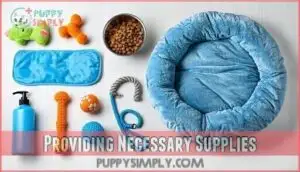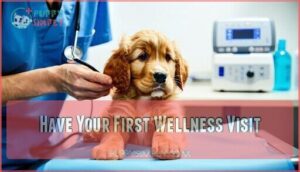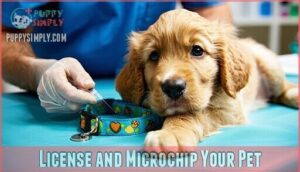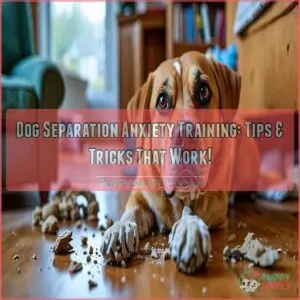This site is supported by our readers. We may earn a commission, at no cost to you, if you purchase through links.
 You’ll need essential supplies before your puppy arrives: food and water bowls, high-quality puppy food, a collar with ID tags, and a sturdy leash.
You’ll need essential supplies before your puppy arrives: food and water bowls, high-quality puppy food, a collar with ID tags, and a sturdy leash.
Don’t forget a comfortable bed, plenty of toys, and waste bags for cleanup duty.
Puppy-proof your home by removing hazards like loose wires and toxic plants.
Schedule that first vet visit within days of bringing your furry friend home. Consider pet insurance early since puppies are accident magnets.
House training supplies like pee pads and enzymatic cleaners will save your sanity. The right preparation turns puppy chaos into pure joy, but timing each step makes all the difference.
Table Of Contents
- Key Takeaways
- Make Sure You’re Ready
- Find The Right Puppy
- Puppy-proof Your Home
- Do a Doggy DNA Test
- Invest in Pet Insurance
- Set Boundaries
- Find a Veterinarian
- Have Your First Wellness Visit
- License and Microchip Your Pet
- House Train Your Puppy
- Frequently Asked Questions (FAQs)
- How to Transition Your Puppy to New Food?
- What essentials should I have before bringing my new puppy home?
- How do I ensure my puppy’s health and safety at home?
- What’s the importance of socialization for my puppy?
- How can I establish a potty training routine?
- What type of training should I start with my puppy?
- How can I ensure my puppy stays mentally and physically active?
- What all do I need for a new puppy?
- Where should a puppy sleep the first night?
- What is the puppy 1/2 rule?
- Conclusion
Key Takeaways
- You’ll need to puppy-proof your home by removing hazards like chemicals, electrical cords, and small objects while securing essential supplies including food bowls, a collar with ID tags, and a comfortable bed before your puppy arrives.
- You should schedule your puppy’s first vet visit within days of bringing them home to establish a vaccination schedule, discuss parasite prevention, and ensure they’re healthy from the start.
- You’ll want to invest in pet insurance early since puppies are accident-prone, and most plans exclude pre-existing conditions, so enrolling while your pup’s healthy protects you from unexpected veterinary costs.
- You need to establish consistent house training routines by taking your puppy outside every two hours, after meals, and before bedtime while using positive reinforcement and crate training to accelerate the process.
Make Sure You’re Ready
Before diving into puppy parenthood, take an honest look at your readiness for this life-changing commitment.
Your new puppy preparation checklist starts with evaluating lifestyle changes you’ll need to make. Consider the daily time commitment required for feeding, training, and exercise.
Puppy parenthood means trading sleep for slobbery kisses and spontaneous adventures—are you ready for the beautiful chaos?
Discuss family agreement on rules and responsibilities with everyone in your household. Research your chosen breed’s specific needs and temperament.
Don’t forget financial planning – puppies require ongoing expenses for food, veterinary care, and supplies throughout their lives.
Asking about the breeder’s breeding experience is also essential for ensuring a healthy start.
Find The Right Puppy
Now that you’ve committed to puppy parenthood, finding your perfect four-legged match becomes the exciting next step.
Start with thorough breed research to understand different temperaments, energy levels, and care requirements.
Consider your lifestyle compatibility honestly – a high-energy Border Collie won’t thrive in a tiny apartment with minimal exercise time.
Explore both puppy adoption through rescue options and reputable breeders.
Check breeder reputation by asking for references, health certifications, and visiting their facilities.
Ethical breeders welcome questions and provide health records.
Rescue organizations often have mixed breeds with wonderful temperaments waiting for homes.
When meeting potential puppies, observe their puppy temperament carefully.
Look for confident but not overly aggressive personalities.
A puppy that approaches you calmly and shows curiosity usually adapts well to new environments.
This puppy checklist step requires patience – the right match will feel natural when you find it.
Puppy-proof Your Home
Puppy-proof Your Home Introduction
Before your new puppy arrives, you’ll need to transform your home into a safe space by removing dangerous items and setting up essential supplies.
This preparation protects your curious pup from household hazards while ensuring they’ve everything needed for comfort and training.
Removing Hazards
Now that you’ve found your perfect pup, it’s time to transform your home into a safe haven. Think of yourself as a detective searching for anything that could spell trouble for your curious new companion.
Your puppy will explore everything at nose level, so puppy proofing requires a thorough sweep of potential dangers.
Puppies see the world through their noses—keep their curiosity safe with a thorough home safety sweep.
Here’s your essential safety checklist:
- Secure chemicals like cleaning supplies, medications, and toiletries in locked cabinets
- Bundle electrical cords up high or use cord protectors to prevent chewing
- Remove small objects that could become choking hazards, including coins and jewelry
- Clear away sharp objects like scissors, knives, and broken items
- Eliminate toxic substances including chocolate, certain plants, and antifreeze
Install puppy gates at stairways and doorways to control access.
To prevent accidental falls, be sure to secure windows properly.
Keep trash cans covered with tight-fitting lids.
Remember, your pup doesn’t know the difference between a chew toy and your favorite shoes.
Smart puppy safety means staying one step ahead of those adorable but destructive impulses.
Providing Necessary Supplies
Your new puppy checklist starts with gathering essential equipment that’ll make homecoming smooth.
You’ll need feeding essentials like stainless steel bowls and high-quality puppy food formulated for growth. Comfort items include a cozy bed and soft blankets for restful sleep.
Training tools such as a properly fitted collar, sturdy leash, and crate help establish routines early. Don’t forget health supplies like puppy pads for house training and gentle shampoo for bath time.
These puppy supplies create a foundation for safety and bonding, turning your house into a true puppy paradise. Remember to research puppy-proofing your home to avoid accidents.
Do a Doggy DNA Test
Understanding your puppy’s genetic blueprint through DNA testing reveals valuable insights about their future.
These tests provide breed identification, health screening for genetic predispositions, and detailed ancestry information that helps you prepare for their specific needs.
Consider these key benefits of doggy DNA testing:
- Breed Identification – Discover your pup’s unique mix and expected traits
- Health Screening – Identify potential genetic health risks early for preventive care
- Trait Analysis – Learn about behavioral tendencies and physical characteristics
This knowledge guides your puppy health approach, from vaccinations to supplements, ensuring personalized care throughout their life.
Invest in Pet Insurance
Pet insurance protects your puppy from unexpected veterinary costs that could drain your savings.
Monthly premiums range from $30-60, covering accidents, illnesses, and preventative care. Research coverage options carefully, comparing policy costs and deductibles.
Understanding the claim process beforehand prevents stress during emergencies. Most plans exclude pre-existing conditions, so enroll early while your pup’s healthy.
Quality puppy insurance guarantees that you’ll make medical decisions based on your pet’s needs, not your wallet. It’s a small investment that guarantees your furry friend receives exceptional care throughout their lifetime, providing peace of mind and ensuring you can give them the best possible life with preventative care.
Set Boundaries
Your new puppy needs clear puppy boundaries from day one.
Decide which rooms are off-limits and stick to these consistent rules.
Don’t let them on furniture sometimes but not others—that’s confusing.
Start with supervised freedom in safe areas, then gradually expand their space.
Use your crate for limiting access when needed, not as punishment.
When they test boundaries, focus on redirecting behavior with positive reinforcement.
Puppy training works best when everyone follows the same rules.
This puppy behavior foundation prevents bigger problems later.
Find a Veterinarian
Your boundaries are set, and now you’ll need professional support for your pup’s health journey.
Finding the right veterinarian means researching vet qualifications and reading online reviews from other pet owners.
Look for clinics offering thorough preventative care, emergency care availability, and transparent vet costs.
Building rapport with your veterinary team guarantees comfortable visits for puppy vaccinations and routine checkups.
Use online directories to locate highly-rated practices near you, and don’t hesitate to call ahead with questions about their approach to puppy health and pet health services.
Have Your First Wellness Visit
Your puppy’s first wellness visit sets the foundation for lifelong health.
Schedule this appointment within days of bringing your furry friend home. This thorough checkup covers everything from nose to tail, ensuring your pup starts strong.
Here’s what to expect during your visit:
- Physical examination checking for congenital issues and overall health
- Vaccination schedule discussion for distemper, parvovirus, and rabies protection
- Parasite prevention recommendations for fleas, ticks, and heartworms
- Behavioral assessment covering training tips and socialization needs
- Nutritional counseling customized to your puppy’s specific growth requirements
Your veterinarian becomes your puppy care partner, guiding you through this exciting journey.
License and Microchip Your Pet
After your puppy’s first vet visit, licensing and microchipping should top your new puppy checklist.
Most states require dog licensing for legal compliance, so check your local requirements.
Microchip benefits include permanent identification that can’t fall off like collars. This tiny chip, inserted between your pup’s shoulder blades, dramatically increases lost pet recovery rates.
It’s your responsibility as an owner to register the microchip with current contact information. These puppy essentials protect your furry friend and fulfill legal obligations simultaneously.
House Train Your Puppy
Success with housetraining starts with establishing a consistent schedule for your new companion. Take your puppy outside first thing in the morning, after meals, and before bedtime.
Crate training accelerates the process since dogs naturally avoid soiling their sleeping area. Many owners find that potty training products can be helpful.
- Designate specific potty spots outside and reward immediately when used correctly
- Clean accidents thoroughly with enzyme spray to eliminate odors that attract repeat incidents
- Use puppy pads indoors as backup while building outdoor habits
Positive reinforcement beats punishment every time for effective puppy potty training.
Frequently Asked Questions (FAQs)
How to Transition Your Puppy to New Food?
Gradually mix new food with your current brand over 7-10 days. Start with 75% old food, 25% new, then slowly increase the new portion to avoid digestive upset.
What essentials should I have before bringing my new puppy home?
Carefully collect core items before your canine companion comes home.
You’ll need a collar, leash, ID tag, crate, bed, food bowls, puppy food, treats, toys, grooming supplies, and cleaning materials for accidents, including a crate.
How do I ensure my puppy’s health and safety at home?
Remove hazards like toxic plants, small objects, and chemicals from your puppy’s reach.
Install baby gates, secure loose wires, and create a safe space with proper ventilation.
Schedule vet checkups immediately.
What’s the importance of socialization for my puppy?
Why wouldn’t you want your puppy to thrive in any situation?
Socialization builds confidence and prevents fear-based behaviors.
Early exposure to people, animals, sounds, and environments creates a well-adjusted, happy dog for life.
How can I establish a potty training routine?
Take your puppy outside every two hours, immediately after meals, naps, and play. Use a consistent door and reward success with treats. Stay patient—accidents happen while they’re learning.
What type of training should I start with my puppy?
Start with basic obedience commands like "sit," "stay," and "come" using positive reinforcement.
Establish consistent house training routines and crate training.
Enroll in puppy classes for professional guidance and socialization opportunities.
How can I ensure my puppy stays mentally and physically active?
Like a growing mind craving adventure, your puppy needs daily mental puzzles and physical challenges.
Rotate interactive toys, teach new tricks, schedule walks, and create obstacle courses.
You’ll build a well-rounded, happy companion.
What all do I need for a new puppy?
You’ll need essential gear: collar, leash, ID tag, crate, bedding, food and water bowls, puppy food, treats, toys, grooming supplies, poop bags, and cleaning products for a smooth adaptation.
Where should a puppy sleep the first night?
Your puppy should sleep in their crate in your bedroom the first night.
This provides comfort and security while establishing boundaries.
Place soft bedding inside and expect some whimpering as they adjust.
What is the puppy 1/2 rule?
The puppy 1/2 rule states that for every month of age, your puppy can hold their bladder for one hour.
So a two-month-old puppy needs bathroom breaks every two hours during the day.
Conclusion
You’ve conquered the mountain of puppy preparation with this ultimate puppy checklist all you need for a new puppy.
From puppy-proofing your home to scheduling that essential first vet visit, you’re now armed with everything necessary for success.
Your new furry companion will transform from a whirlwind of chaos into your most loyal friend.
Remember, patience and consistency are key during those first few months.
You’ve got this – welcome to the wonderful world of puppy parenthood!
- http://akc.org/expert-advice/training/how-do-you-raise-a-confident-puppy/
- https://www.homesalive.ca/promotions
- https://homesalive.ca/dog/food/dry-and-kibble.html
- https://www.akc.org/expert-advice/health/how-to-find-best-veterinarian/
- https://www.humanesociety.org/resources/why-you-should-spayneuter-your-pet















